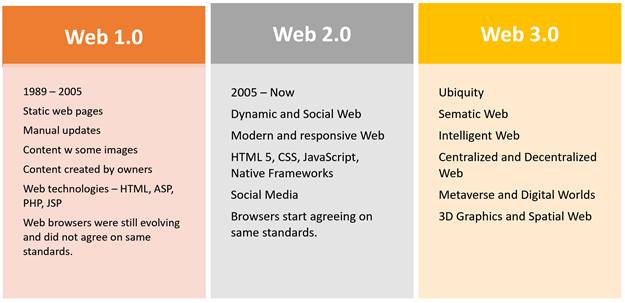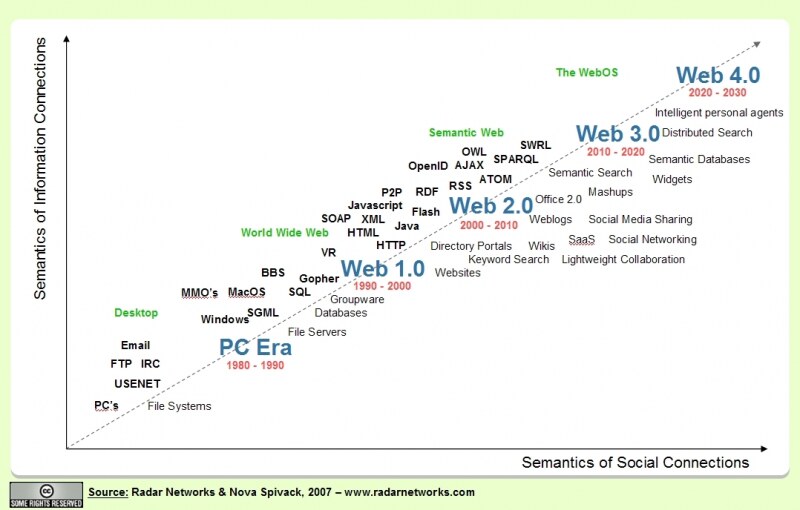What is Web 1.0, Web 2.0 and Web 3.0?
Web 1.0 is the first generation of web development, which is characterized by static HTML pages. Web 2.0 is the second generation of web development, which is characterized by dynamic content through AJAX and XMLHttpRequest. Web 3.0 is the third generation of web development, which has been predicted to be a time when people will be able to interact with data in real time with artificial intelligence and machine learning technologies.
The difference between web 1.0 and 2.0 are that in the first one, there was no dynamic content while in the second one there was dynamic content through AJAX and XMLHttpRequest.
The difference between web 3.0 and 2.0 are that in the third one people will be able to interact with data in real time with artificial intelligence and machine learning.
Web 1.0
Web 1.0 is the first generation of the internet. It was a time when people were just exploring the internet and using it for research purposes. Web 2.0 came about when people started using social media, blogging and other interactive technologies to share information. Web 3.0 is the latest generation of the internet, where AI and machine learning are used to process information and make decisions based on that data.
The first web revolution was focused on delivering content to users. It was the era of information and publishing. Websites would publish content and readers would visit them to read it.
Web 2.0
It was a time of social media, user-generated content, and open platforms for collaboration. The web became more interactive with the rise of blogs, wikis, and social networking sites like Facebook and Twitter.
Web 3.0
The third web revolution is about artificial intelligence (AI) and machine learning that are powering the next generation of applications for consumers in education, healthcare, retailing, transportation, finance etc., as well as enterprise solutions that are transforming how organizations operate internally in areas such as sales or customer service management or externally in their dealings with customers.

Web 1.0 was about static pages with little to no interactivity and web 2.0 was about user generated content and social media. Web 3.0 is the next step in the evolution of the web and it is all about AI and machine learning.
Web 3.0 is a representation of what we can expect from the future of the internet, it has been created by taking into account artificial intelligence and machine learning technologies that have been developed in recent years. It is an evolution from web 2.0 which focused on user generated content, social media, and interactive applications such as blogs, wikis, chatrooms etc., while web 3.0 focuses on artificial intelligence technology that enables machines to learn without being explicitly programmed to do so; this includes deep learning algorithms as well as natural language processing.
Web 1.0 was the first generation of the internet and it included websites like Yahoo, AltaVista, and Lycos. Web 2.0 was a term coined by Tim O’Reilly in 2004 to describe how the internet had evolved from a static text-based medium to a more interactive, user-generated content driven medium. Web 3.0 is the current generation of internet which includes social networks such as Facebook, Twitter, LinkedIn and Instagram.
Web 1.0 is characterized by static pages with limited interactivity or user generated content. Websites were mainly used for information retrieval and publishing rather than communication with other people or communities of interest. Web 2.0 saw an explosion in web usage due to increased interactivity, user generated content and social media platforms such as Facebook, twitter etc.
Web 1.0: Static pages, passive user experience
Web 2.0: Interactive features, engaging for users
Web 3.0: Artificial intelligence, machine learning
Web 1.0: Web 1.0 is characterized by the use of HTML and CSS to create a website, which are then uploaded to the internet.
Web 2.0: Web 2.0 is characterized by the use of AJAX, JavaScript, and Flash to create a more interactive website with more user-generated content.
Web 3.0: Web 3.0 is characterized by the integration of artificial intelligence (AI) and machine learning into websites that can learn from user behavior and adapt accordingly
The web has gone through three different stages – web 1.0, web 2.0, and now web 3.0 which is driven by AI and machine learning technology.

